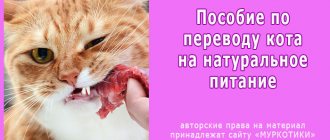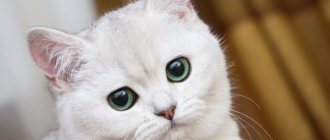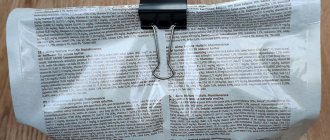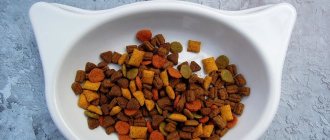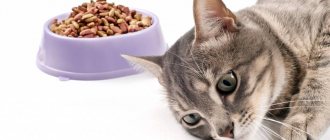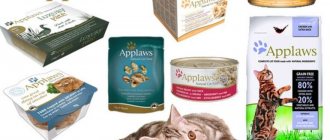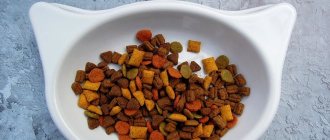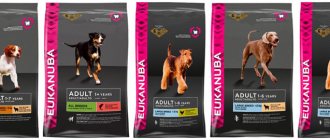What will you learn from the article?
- How to transfer a cat from dry food to wet food. What is the difficulty of the transfer?
- Step-by-step guide - how to switch a cat from a dry diet to a wet diet
- Useful tips
- Difficulties of switching to natural nutrition
- Useful tips
- How to wean a cat off whiskey and other economy-class food
- How to switch to a new kitten food
Sometimes cat owners are faced with the fact that their pet needs to be switched to another type of food. The reasons for this can be various: food allergies, intolerance to certain foods, switching to a premium brand of food, a veterinarian prescribing a therapeutic diet; a new stage in the pet's life.
Cats are very picky eaters, they have a sensitive gastrointestinal tract, so you can’t just switch them to a new type of food or brand of food overnight. The process of weaning off one food and getting accustomed to another is long and gradual. It requires endurance and patience from the owners.
In this article we will cover:
- how to wean a cat off the food he is used to;
- how to change the type of food without harming the cat’s health;
- how to switch your pet to a new brand of food.
How to switch a cat from dry food to wet food
Most often, cat owners are faced with the need to wean their cat off dry food and switch the pet to a wet diet. This process is especially difficult for animals that have been fed granulated industrial feed since birth. For them, changing their diet can be stressful.
Owners who are faced with the need to transfer their pet from a dry diet to wet canned food must competently approach the solution to this problem. Cats are hostage to their taste preferences; they may be reluctant to try new foods or go on a hunger strike.
What is the difficulty of translation?
A special feature of a diet based on wet food is that food is given 2-3 times a day. Anything that the cat hasn’t finished eating needs to be removed. Wet food cannot be kept in a bowl all day, it will spoil. Cats that are used to having dry kibble in their bowl all day may not immediately get used to this diet.
The second difficulty is that cats don’t like change. They find it difficult to transition from the hard, crunchy texture of kibble to the soft, moist texture of canned food. In addition, manufacturers of some brands of inexpensive food add additives to the granules, the taste of which animals really like.
Step-by-step guide - how to switch a cat from a dry diet to a wet diet
Step 1
We wean the cat off the fact that there is always dry food in the bowl. We divide the daily portion into 2-3 feedings and pour it in at a certain time for 20-30 minutes. We remove everything that the cat does not eat. The bowl should be empty and clean until the next meal. Only a bowl of water should be filled around the clock.
Cats, accustomed to a constantly filled bowl, may resist and beg for food with plaintive meows. Be firm and consistent, do not follow the animal's lead. Only fill the bowl when it is time to feed and remove any uneaten food. You can offer your cat some wet food between meals to familiarize him with it.
Why this step: many cats refuse to try new food if the bowl is constantly filled with dry food. It may take them 1-2 weeks just to get used to food being given out on a schedule.
Step 2
Once you have passed the first stage and noticed that the cat is accustomed to feeding on a schedule, proceed to a gradual change in diet.
Diet change formula:
- Day 1-2: 90% – dry food; 10% – wet food;
- 3-4 days: 75% – dry food; 25% – canned food;
- Day 5-6: 50% – granules; 50% – canned food;
- 7-8 days: 25% – dry food; 75% – wet;
- Day 9: 100% – wet canned food.
Some animals may need a longer time to adjust to the new diet. Do not rush your pets; proceed to the next stage only when the cat is ready.
Carefully monitor your pet's well-being and behavior during this period of time. At the slightest deviation from the norm, contact your veterinarian.
Stick to the indicated proportions, gradually increase and decrease the portion of the new food, do not try to accustom the animal to a changed diet in one day.
Useful tips
If your veterinarian recommends switching your pet to a wet diet, purchase a new food and be patient. Buying new food is the easiest part of the cat retraining process. To achieve success you will need: time, patience and some tricks.
- Be patient and be prepared for the training process to take from several weeks to 2-3 months.
- Purchase wet canned or bagged food from the same brand your pet is used to. This will help ensure proper digestion and keep the calorie content of food at the level the animal is accustomed to.
- If your cat is unfamiliar with wet food, help make it more appealing. Warm cooled food to room temperature. Make sure the food is not too hot - this will repel the animal.
- Offer canned food in a flat dish, or place some warm, wet food near your cat's bowl so your cat can lick it off easily.
- Don’t rush to switch your cat to a new food, do it smoothly and gradually.
- Reinforce the result with positive motivation for your pet. Gently call him to the bowl of food, talk to your pet, praise him every time the cat tries a new food.
- Crush the wet food with a fork, spreading it around the bowl so that the cat eats the food more slowly and does not swallow the food in one piece. Ingestion too quickly will negatively affect the animal's digestion.
Read: Is dry food bad for cats?
Video
Preparing the diet
Despite all the claims of advertisers and sellers of dry food, veterinarians say that the diet of cats should consist of the following products:
- Fish or meat – 45%;
- Animal proteins – 20%;
- Vegetables and grains – 20%;
- By-products – 10%;
- Minerals and vitamins – 5%.
Of course, dry food made from various wastes and chemical additives does not contain all this. And more expensive canned food will only be an ineffective replacement for full-fledged food. How to create a suitable diet, in which it would be easy to wean your pet off of store-bought food, so that he lives for many years, looks and feels great? Everything here is extremely simple - try feeding your cat natural food.
With meat and fish, everything is clear - a cat, as a predator, needs these products. Feeding your pet real meat is not a cheap pleasure. Therefore, it is better to use fish - sea or river, whichever is easier for you to purchase.
But here you should take into account that if you feed river fish as the main food, it will be useful to boil it. Fish living in fresh water (especially in stagnant water) may contain eggs of worms and other parasites. The cooking process will destroy them. It is enough to put small fish or large pieces (no need to clean or gut them) into boiling water, bring to a boil and cook for 10-15 minutes. The fish will remain tasty, the parasites will die, and the cats will happily drink the broth to the last drop.
© shutterstock
With animal proteins, everything is also quite simple - what cat would refuse a cup of milk ? It is not necessary to wean him off dry food so that he can enjoy milk, cream or even yogurt. Some owners also give their pets raw eggs. But there is an opinion that this damages the liver of animals. Therefore, if you add raw chicken eggs to your diet, you should do this as rarely as possible.
There will be no problems with vegetables and grains either - when you cook fish, you can throw some rice, carrots and potatoes into the broth. Healthy cats eat the resulting thick “ear” with great pleasure, receiving all the necessary microelements.
There are no problems with offal either. Once or twice a week, give your cat liver soup rather than fish soup. To do this, replace the fish with chicken liver or finely chopped beef or pork. Even the most picky and spoiled cat will not refuse boiled liver. Therefore, it can be used to wean a cat off cat food.
Vitamins can be added to ready-made and already cooled food. A few drops of medications purchased at a veterinary pharmacy will be mixed in the broth and will provide the cat with everything it needs.
It would be a good idea to grow special cat grass on the windowsill - the seeds are sold in veterinary pharmacies. And if it is possible to let the cat out for a walk in the summer, then she will solve the problem herself by finding and eating the necessary plants in the country.
How to switch a cat from dry food to natural food
Supporters of natural nutrition are often faced with the need to switch a cat from dry food to natural food. This happens when an adult pet is taken into the home from a shelter or a kitten that the breeder fed with industrial pelleted food.
To clarify, switching to natural food does not mean accustoming you to home-cooked food from your table. Human food is not designed to be fed to a cat. A pet’s natural diet is a specially developed diet that contains products that provide the animal with all the necessary substances.
Difficulties of switching to natural nutrition
- Pets accustomed to ready-made food may at first refuse natural products, not considering them edible.
- Owners will have to specially prepare food for their pets, carefully calculating the diet so that it contains all the necessary micro- and macroelements.
- Feeding “natural” provides for the additional introduction of vitamin and mineral complexes. Premium class industrial dry food has a balanced vitamin and mineral composition.
Step-by-step guide - how to switch a cat from dry food to natural food
Step 1
Once you have decided to change your pet's diet, visit your veterinarian. The doctor will assess the animal’s health, find out if there are any contraindications for such a diet, and recommend vitamin and mineral complexes. Health problems and old age of the cat may be a contraindication for a radical change in the type of diet.
Step 2
If your pet is used to having his bowl constantly filled with dry food, you will have to first train him to eat on a schedule. Without offering natural food, we divide the daily feeding rate into 2-3 servings. We fill the cat's bowl with dry food at certain times: morning, afternoon and evening. Anything the cat hasn’t eaten will be removed after half an hour.
Step 3
We move on to this stage only when the cat is accustomed to feeding “on the clock” and does not require food in between feedings. Each pet has its own pace, do not rush the animal. In the third step, we let the cat try wet food and teach it that food is not always dry. To begin with, you can soak the usual granules in water and offer them to the cat in this form.
Next, add natural products to the cat’s diet:
- First stage: 10% – natural products (chicken fillet, unsweetened cottage cheese); 90% – drying.
- Second stage: 20-25% – natural food (add rabbit meat, lean veal, chicken stomachs, boiled sea fish fillet); 80-75% – dry food.
- Third stage: 50% – natural; 50% – dry food.
- Stage four: 75% – natural food; 25% – granulated feed.
- Fifth stage: 100% natural nutrition.
Useful tips
- New products are being introduced gradually. You can offer your cat one new product every 3-4 days. This is necessary in order to observe the animal and evaluate how the pet’s body reacts to different foods.
- If you identify an allergy to a particular type of food, you should contact your veterinarian.
- Give meat products in finely chopped pieces - the cat must learn to chew such food.
- Give food strictly on time. After 15-30 minutes, remove the bowl of food so that the food does not turn sour. The animal must understand that you will not offer other food. Water should be available to the cat 24/7.
- Make sure that the transition to natural food is smooth; a sudden change in diet can provoke a hunger strike on the part of the animal and cause problems with the gastrointestinal tract.
- Do not keep dry industrial food in the house so that the cat does not smell it. Your cat's sensitive sense of smell will detect its familiar favorite aroma, even if you hide it.
- At the last stage, do not give in to pity, do not react to plaintive meows, and do not give the cat dry food.
It is unacceptable to mix natural food and dry food during one feeding - the cat’s gastrointestinal tract is not able to digest them at the same time.
Video
How to teach a kitten to eat on its own?
To learn to feed from a bowl, it is important: the kitten lives with or without its mother.
If the baby is with his mother, then she can teach him everything that is useful in life: to eat, meet the enemy, escape from bad weather. When a cat teaches her baby to eat, she demonstrates to him how she puts her muzzle in a bowl and makes grasping movements, crushes food, and swallows it. A cat often invites its child to eat with its appearance and purring sounds.
The kitten's brain is a sponge, absorbing information from its mother. He is able to repeat everything his teacher shows.
But in practice this is not always the case; many feline maternal responsibilities are taken on by the pet owner.
If you had to do the training, then know that the baby is ready not only to adopt the owner’s eating style, but may also show a desire to brush his teeth like you, or go to the toilet on the toilet. Start learning to feed yourself by personal example.
Show your kitten that you are eating from a bowl on the floor, and he will copy you. If not, then help him: take the bowl and place it on your lap. Create a cozy environment for your baby. After all, cats are sensitive to spiritual warmth.
Spread food on your pacifier or finger. Then the baby will remember how he ate his mother’s milk and will lick the food.
How to wean a cat off wet food
The principles of weaning a cat off wet food are the same as in the cases discussed above:
- subsequence;
- phasing;
- monitoring how the animal tolerates new food.
A transfer from feeding wet canned food to “drying” can be caused by:
- veterinarian recommendations;
- The desire of the owners to improve the quality of the animal’s nutrition by switching the pet to super-premium food or “holistic food”.
The complete translation may take several weeks. First, the cat is offered dry granules soaked in water so that the animal becomes familiar with a new type of food. New food should be offered when the animal is hungry. A cat that has eaten its usual diet may not show interest in unusual food.
Further, the granules are offered in dry form; cats usually like the crunchy texture of this food and crunch with pleasure. For some pets, the new taste and texture may seem too unusual - they will refuse to “dry”. Don't worry about this, give your cat time to get acquainted and get used to the new food.
Useful tips
- Carefully monitor the animal's reaction, make sure that the cat eats, do not allow a complete hunger strike - this is dangerous for the liver.
- Feed by the hour. At the initial stage, you should not pour food into a bowl and keep it there all day. Give out food in portions at strictly prescribed times.
- Be patient, don't rush your cat, reward him every time he agrees to try a new food.
Make sure your cat has 24/7 access to clean, fresh drinking water. Animals on a dry diet must receive sufficient fluid.
Video
Gentle introduction to new food
The best way to accustom your cat to natural food is to begin gradually replacing dry food with it, mixing them. A complete replacement will take 10–14 days. There is no need to rush - a sudden switch to food of a different composition and consistency can cause stomach upset.
It must be remembered that unsystematic eating of different foods leads to metabolic disorders - for example, to hypervitaminosis. Changing the diet is one of the few situations in a cat's life when mixing is acceptable.
How to switch a cat to another food
It may seem that the simplest situation is when the owners do not change the type of food (dry, wet), but simply decided for certain reasons to change the brand. This is a misconception; transferring an animal from one brand to another also requires time and patience of the owners.
Reasons for transferring to another brand:
- transition of a kitten to an adult age group;
- medical indications (therapeutic and prophylactic brands);
- pregnancy;
- sterilization, castration;
- recovery in the postoperative period;
- identifying intolerance to certain foods;
- advanced age;
- allergy;
- transfer to a premium brand (super-premium, holistic);
- The brand of food that the cat is accustomed to has been discontinued.
New cat food is introduced into the menu gradually over 10-12 days. In the first 1-2 days, offer the animal only 20% of the new brand of food. The rest of the serving should be the pet’s usual food. Increase the amount of new food in the diet by 10% every day until you reach 100%.
Throughout the transition period, carefully monitor the condition of the animal. If you notice allergic reactions, signs of gastrointestinal upset, changes in behavior, stop giving new food and show the animal to a veterinarian.
How to wean a cat off whiskey and other economy-class food
This can be difficult. Manufacturers of economy-class food add artificial flavors, dyes and taste enhancers. Therefore, many cats quickly get used to such food and are very fond of cheap food from supermarkets.
However, such food can be harmful to your pet's health. The composition of these brands is not sufficiently balanced; these foods contain little protein but a lot of carbohydrates. Economy brands, such as Whiskas, Kiteket, Friskies, have low energy value; cats need to eat large portions to get enough.
Owners will need time and patience to change their pet's taste preferences. This cannot be achieved in one day. You need to tune in little by little and gradually add new food of better quality to the diet. The cat may ignore it, choose an old brand of granules, or leave new food of an unusual taste in the bowl.
You need to patiently offer your cat food of a new brand, calmly and restrainedly treat its whims and pitiful meows. When the animal understands that there will be no other food, it will have to eat what is given. The owner’s task is to calmly react to possible failures and praise the pet if he has at least tried a new taste.
Video
Why do cats develop a persistent addiction to freeze-dried food?
Not too scrupulous and conscientious manufacturers, in the struggle for market share, add a lot of specific substances to their products (flavors, taste enhancers and other synthetic additives), which first attract animals (addictive substances), and then cause sustainable addiction (attractants) - a kind of “narcotic” " addiction. This is especially true for the most accessible and cheap cat food of the economy and super economy class (Friskies, Whiskas, Kitiket, etc.). At the same time, other food becomes unattractive and is not perceived as potential food.
Cheap dry food is addictive
Video: the dangers of dry food
How to help your cat switch to a new food
- Feed your cat in a quiet, private place, away from people and other pets.
- Offer new food to your cat by hand.
- Talk kindly to your animal when giving him new food. Praise when your cat tries even a piece.
- Slightly warmed food smells more fragrant, try heating new food to increase its attractiveness in the eyes of your pet.
- If your cat likes the fishy smell, you can add a little tuna oil to the food.
- Mix new food with old food so that the cat does not have the opportunity to choose the usual food and refuse the unfamiliar.
- The main rule is that if a cat refuses new food, do not let him starve. Go back to the old food and try to switch to the new diet a little later.
- Experiment with different tastes, find the taste that your cat likes best.
What should be included in the diet?
For your pet to live a long and healthy life, it needs to be fed properly. What do cats like to eat and what should be included in their weekly diet?
Try to regularly give your cat the following foods:
- Raw lean meat. Chicken, rabbit, turkey or beef are great.
- Fish. It also should not be greasy and must undergo heat treatment.
- Egg yolk. One piece per week is enough.
- A variety of dairy products. Here, too, you need to remember about fat content.
- Broths and soups. Diversity is allowed here. The main thing is that the pet likes it.
- Boiled liver and offal.
- Raw and stewed vegetables. It all depends on the individual preferences of the animal. Some people like melon, others like cucumbers.
- Cereals in the form of porridges and casseroles.
Many less experienced owners are interested in whether cats can have cheese? On the one hand, it seems to be a dairy product, but on the other, it is quite fatty and can cause harm to the animal. The answer in this case is quite simple. If you occasionally pamper your pet with a small piece, nothing bad will happen. But you shouldn't feed your cat cheese regularly.
Another, no less popular question: can cats fish? It is possible, but only in processed form. A large number of heavy metals, helminths and other parasites that can be found in raw fish can cause irreparable harm to your pet.
Features of switching cats to another food at different periods of life
At different stages of a cat's life, the process of transferring to a new diet should be structured differently. It is important to choose the right time and choose the most suitable methods of accustoming to new food.
How to switch to a new kitten food
Kittens are switched to adult brands of food at 12 months of age. This must be done because older pets require more nutrients. The composition of brands marked “for kittens” is not suitable for adult cats.
Curious kittens love to discover new things, including tastes, aromas and textures. They may enthusiastically eat new types of food. Maintain your kitten's enthusiasm with a positive attitude, praise and affection. This positive experience will help in the future, if necessary, to wean the cat off food and switch it to other products.
Don't rush your pet. Even if he willingly eats new food. Give his digestive system the opportunity to readjust and get used to the changed composition. Gradually introduce new food over 5-7 days, gradually adding it to the usual food.
The transition from kitten food to an adult diet should be smooth and easy. Throughout the transfer period, make sure that the kitten has clean drinking water, monitor its appetite, stool and well-being. This will help determine the cat’s attitude towards new food and tell you about its health.
How to change the diet of shelter cats
Once you adopt an adult cat from a shelter, it can be tempting to quickly switch her to a different, better quality food. On the one hand, this desire is understandable - shelter food is usually not distinguished by quality and balance.
On the other hand, a cat that finds itself in a new environment experiences severe stress. Because of this, he may have digestive problems. Veterinarians recommend feeding the animal the food it is accustomed to for the first month. And only then try to gradually change your diet.
Sources:
- https://www.hillspet.com/cat-care/nutrition-feeding/switching-cat-food
- https://www.veazievet.com/feline-wellness/adult-cat-wellness/food-choices-maintaining-a-healthy-weight/transitioning-your-dry-food-junkie-to-a-wet-food- connoisseur/
- https://veterinarypartner.vin.com/default.aspx?pid=19239&catId=102902&id=4952909
- https://www.darwinspet.com/resources/transitioning/cat.html
- https://www.askthecatdoctor.com/switching-cat-food-brands.html
What should cats eat?
We have already told you what can be included in the diet of an adult animal. Now let's talk about proportions. Proper nutrition that provides the cat with all the necessary elements should look something like this:
- 45% – meat and other protein foods (dairy products, eggs, sometimes fish);
- 20% – offal (offal, lungs, liver, heart);
- 20% – vegetables, cereals, various sources of fiber and microelements;
- 5% – vitamin complexes, oil, bone meal.
Home feeding diet
The main product in this type of diet is meat, about 80%. The rest is cereals, vitamins, vegetable supplements. Natural feeding requires an accurate calculation of the daily food intake; the idea that the cat itself knows how much it needs to eat is wrong. Often, fluffy beauties, without knowing the limits, gobbling up delicious foods on both cheeks, acquire excess weight, heart and respiratory problems. Different ages are taken into account when compiling the daily menu.
How to calculate a kitten's nutritional intake
Two and a half months is the age at which a baby can be separated from its mother. Before nine months, the kitten should receive no more than 10% of its weight in food. With a weight of 2000 g, the weight of the daily portion is 200 g. 50% is meat food, 50% is fish products.
Best articles: Sheltie - a playful, fluffy, affectionate dog
How to calculate the amount of food per day for an adult cat
An adult animal needs only 5% of its weight in feed. With an animal weighing 5 kg - 250 g of natural food, consisting of equal parts of fermented milk and meat products. 20 g of vegetables and a few drops of vegetable oil are allowed. Active pets, who expend a lot of energy, are given more food, inactive, obese, and elderly pets require less.
Dangerous consequences of eating ready-made food
No matter how beautifully dry food manufacturers advertise their products, most of them try not to voice the fact that the constant consumption of industrial food by animals leads to disastrous consequences. And among them, veterinarians most often note the following:
- vitamin deficiency (not all feeds contain exactly the vitamins and microelements that are indicated on the packaging);
- dysbacteriosis (for preservation, carcinogens and various chemicals are added that cause indigestion and metabolic disorders);
- urolithiasis (neutered cats are especially susceptible to this disease, although cats are not immune from kidney disease);
- allergic reactions (since the basis of dry food is legumes, animals experience flatulence and bloating; due to the dyes included in the composition, problems with hair and skin can occur - itching, sores, baldness).
What do cats eat?
Undoubtedly, every caring owner tries to organize the correct nutrition system for their furry pet. A balanced, nutritious, fortified diet is the key to excellent well-being, activity and health of our little brothers. But have you ever wondered which foods bring real benefits to the body, and which should be excluded from your pet’s diet?
Many owners of furry cats believe that the cat's favorite food is milk and fish. We all remember well children's fairy tales, where illustrated pictures show a tabby cat licking his lips at the sight of a jug of milk or happily gobbling up a fish caught from a pond. But in fact, this is a completely erroneous opinion. Milk is the main food of newborn kittens, and adult animals do not have enzymes that digest lactose.
The gastrointestinal tract of cats does not accept sweet foods or foods containing large amounts of carbohydrates. Sugar and any other sweets can cause allergies, and chocolate is poison for a cat and even a small piece can cause a coma.
We recommend: DIY cat scratching post: the main way to protect surfaces in the house
The cat's diet should consist of 90% meat, which is the main source of protein if the pet is kept on natural food. You can supplement your diet with herbs, cereals, and dairy products. When choosing a ready-made type of food, you can feed animals only with high-quality food from well-known brands.
Remember, if the cat is kept on a natural diet, in order not to provoke poisoning, there should always be fresh food and water in the bowl. With a ready-made diet, even though the granules do not spoil or weather, wash your cat’s dishes after each feeding.
